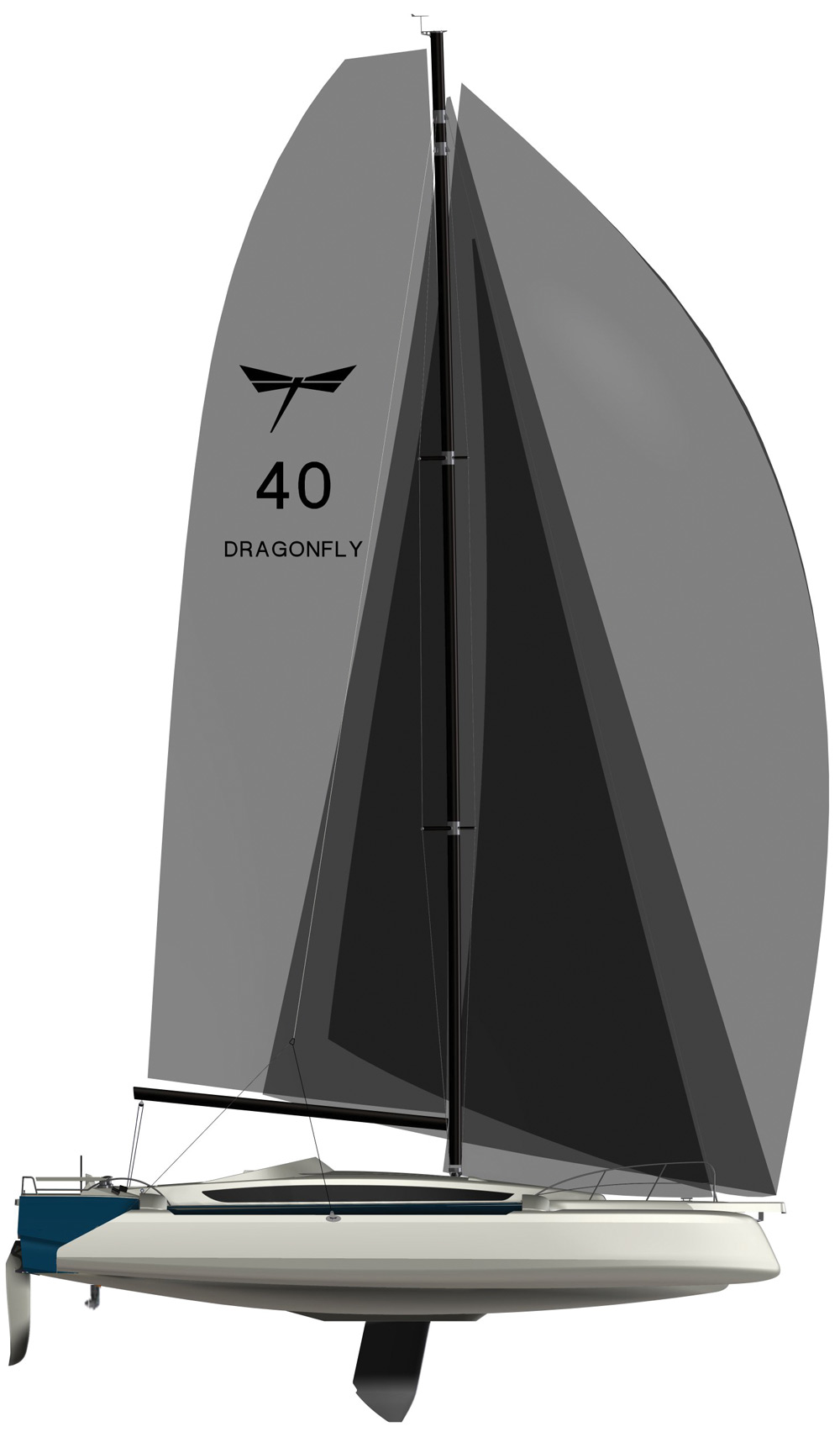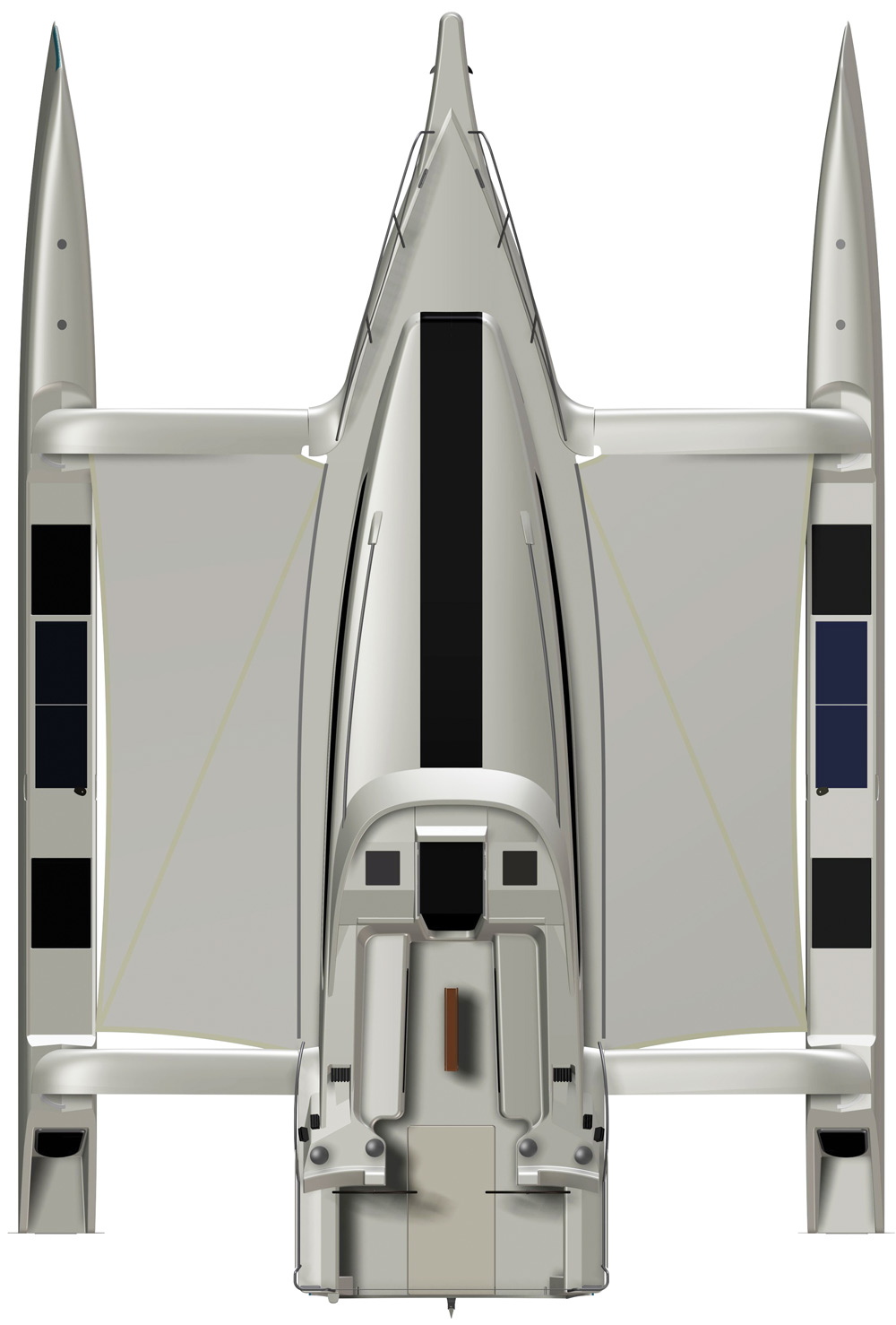Dragonfly 40
This folding trimaran for fun cruising offers plenty of options
Holy cow! We have a 40-foot folding trimaran to review. This will be fun. My buddy Doug, who lived on the next beach, had one. It wasn’t a Dragonfly but it was similar and not as nice as the Dragonfly tris. He would fly by in the afternoon, usually by himself. He’d toot his horn and wave at me just to piss me off. Once in a while he’d snuggle his tri up to the beach and pick me up. Off we’d fly at an effortless 14 knots. I found the only way to get a clear idea of our speed was to look at the wake.

It’s kind of hard to know how to use the typical numbers I use to compare monohulls. Calculations involving weight are missing one huge variable, ballast. I suppose you could use the weight of the amas and akas and call that ballast. But that is complicated and a bit of a stretch. This tri comes in four configurations: Touring, Ultimate, C Ultimate and C performance. The “C” designates a carbon fiber build. I’ll restrict myself to the Ultimate version.
The boat displaces 12,786 pounds ready to sail. That gives us a 106.3 D/L. If I use the “max total weight with crew” displacement the D/L jumps to 165. I appreciate being given what appears to be accurate displacement numbers for a change. A D/L of 165 fully loaded is still light and right in line with what a ballasted, high-tech racing monohull would be. Max beam is 27 feet 6 inches when sailing. Fold the amas in and the beam goes down to 13 feet 2 inches. Note the wave piercing bow profiles on the amas.
Draft, with what I think is a centerboard down, is 7 feet 3 inches. Board up draft is 2 feet 3 inches. Look at that very high-aspect-ratio rudder. Mr. Quorning says that max angle of heel will be around 5 to 7 degrees. Your beer should stay put at those angles. For fun I scaled the drawing to get an idea of the L/B of an ama. I got 16. Compare that to a narrow monohull with an L/B of 4.2.
This extreme narrow beam becomes a problem when it’s time to layout the interior. Designers want to retain a narrow BWL on the main hull for performance so in order to gain usable interior volume they resort to tricks like flaring the topsides out kind of like a margarita glass. This flared portion of topsides should never be in the water. This layout could sleep four comfortably and six in a pinch. I suspect the V-berth can be converted to a double berth. The promotional material says that there is room at the dining table for eight people. I figure each person needs 24 inches of seat to be comfortable. If you all ate in your underwear you could probably reduce that to 20 inches. I don’t see it in this drawing, but I can envision six people sitting in comfort. That’s plenty. I can’t say any more about the interior. I’d have to guess at what I’m looking at. The rendering I have is not very definitive.
Using the Ultimate version I get a SA/D of 23.97. That is with the self-tacking jib. That should be plenty of sail area unless you are a hard-boiled racer.
I’m sorry my pal Doug is no longer with us. He was getting in the mood for a new tri. But his ultralight aircraft let him down. I’m pretty certain Dougy would have been all over this new Dragonfly 40. I would have enjoyed seeing him fly by the shack.
LOA 40’8”; LWL 37’9”; Beam 27’6”, folded 13’2”; Draft board up 2’3”, board down 7’3”; Displ. 12,786 lb.; Sail area 1,098 sq. ft.; Auxiliary 57-hp; Water 58 gal.; Fuel 40 gal.; D/L 106.3; SA/D 23.97
Our best estimate of the sailaway price: $975,000


Comments